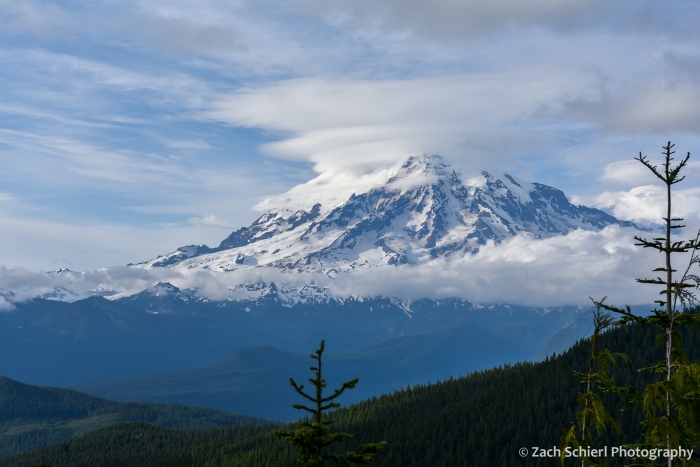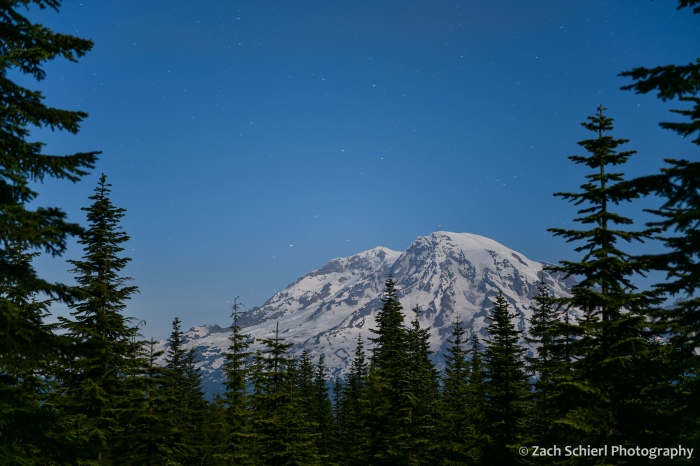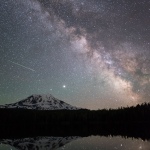Summiting Mt. St. Helens


Looking east along the crater rim of Mt. St. Helens to Mt. Adams in the distance.
Of all the volcanoes in the northern Cascades, Mt. St. Helens is by far the easiest to climb. For starters, the most common route, Monitor Ridge on the south flank, is non-technical, eliminating the need for specialized gear or advanced mountaineering skills. At just 8,366 feet, its summit elevation post-1980 eruption places it several thousand feet lower than neighbors such as Mt. Adams, Mt. Baker, and Mt. Rainier, essentially taking the ill effects of altitude out of the equation. However, at 10 miles round trip and with about 5,000 feet of elevation gain, it’s still a robust day hike.
After numerous trips to the base of Mt. St. Helens over the years, reaching the summit of this active volcano has long been on my to-do list. When we moved back to Washington last summer, I knew I might finally get my chance. The Gifford Pinchot National Forest limits the number of climbers to 100 per day in the summer months, and the permits sell out quickly when they go on sale in March. Sadly, I missed the initial sale this year, leaving me to obsessively check every few days for cancellations. Eventually I got lucky and spotted two permits up for grabs in late-July. A few minutes later, they were mine.
From a distance and elevation gain standpoint, the hike up Monitor Ridge is comparable to many of Colorado’s famous “Fourteeners”. One major difference: on Mt. St. Helens we would be topping out at a lower elevation than one starts most Fourteener climbs at. The other big difference would be the terrain. Most Fourteeners have a fairly distinct path a good way up the mountain and are on reasonably solid rock (my dislike of exposure and falling means I haven’t done any of the ones on rotten rock). On Mt. St. Helens, after a brief foray through the forest, the climb traverses a mixture of large lava boulders and a loose scree consisting of pumice and volcanic ash. This is a hike where a mask was on the suggested gear list before they were cool!
To the hike! As the National Weather Service had accurately predicted several days in advance, the morning of our climb dawned with some fairly dense fog at the Climbers Bivouac trailhead where we had camped the previous night. We hit the trail at 6:00 am, anticipating that it would take us 4-5 hours to reach the summit. The first two miles of trail climbs gently through a moist and somewhat unremarkable second growth forest. At timberline is where the route changes from a well-maintained trail to the aforementioned scree and boulder scramble. Wooden posts serve as guides for the remainder of the climb, but following them too closely didn’t always make for the most sensible route. In places there is a fairly obvious path, while in others (particularly in the boulder fields), you just sort of have to find what works best. Just before arriving at timberline, we began to emerge from the clouds, revealing views of Mt. Adams to the east and the extremely conical Mt. Hood to the south that we enjoyed the rest of the day. Once above the trees, our pace slowed significantly, but before too long we were several hundred feet above the cloud deck we had been immersed in a short time earlier:

Breaking out of the trees on the Monitor Ridge route.

Heading up Mt. St. Helens with the clouds below us and Mt. Hood in the background.

Nearing the top of the boulder field on the Monitor Ridge route. Only a mile to go!
We made fairly good time through the ~2 miles of boulder fields. The final mile through a deep and loose mixture of volcanic ash and pumice was definitely the most challenging part of the hike. With masks on to prevent inhaling clouds of ash kicked up by our feet (and the wind), it was somewhat analogous to hiking up a sand dune: two steps forward, one step back, repeat. After about four hours, we were standing on the crater rim.
The first view northward into the bowels of Mt. St. Helens was stunning, and definitely one of the most dramatic viewpoints I can recall. Unlike many lesser peaks in the Cascades, or most peaks in the Rockies, where you are often surrounded by other peaks of comparable elevation, Mt. St. Helens stands alone. On this volcano, you are standing on what is, by far, the highest point for dozens of miles in any direction, with only the other volcanoes exceeding you in height. Looking down onto the crater formed by the 1980 eruption, the lava domes that are slowly rebuilding the summit, and the Crater Glacier (one of the few alpine glaciers in the world that is actually advancing) was spectacular. Cornices of hard-packed, dirty snow clung to the nearly vertical slopes of the crater walls just beneath our feet, necessitating caution as we moved our way along the rim. Gentle puffs of steam were visible on portions of the lava dome, a gentle reminder that we were standing at the summit of one of the most active volcanoes in the world. The dull roar of rock and ice fall from the crater walls was nearly constant for the hour we spent taking in the view from the summit.

Panorama from the Mt. St. Helens crater rim, looking north across the lava dome and Crater Glacier to Spirit Lake and Mt. Rainier. (Click image to enlarge)

Panorama looking south from the crater rim. Mt. Adams at left, Mt. Hood just left of center. (Click image to enlarge)

Clouds part to reveal Spirit Lake and the distant cone of Mt. Rainier, more than 4,000 feet higher that Mt. St. Helens.
While the hike up had been relatively uneventful, the journey down was definitely less pleasant. Hiking poles are a must for the descent due to the steep, loose, and rocky terrain. This is definitely one of those hikes where coming down is exponentially more difficult than going up!
Compared to our experience hiking Fourteeners in Colorado, the significantly lower elevation of this hike makes a huge difference and in my opinion dramatically lowers the overall difficultly of this route. There is a big difference between inching your way up a scree slope at 13,000′ and having to stop every few steps to take in oxygen, and doing the same at 8,000′ where breathing isn’t as much of an issue. While the terrain was definitely more difficult than your average hike with similar specs, in the end we felt like the difficulty of the Monitor Ridge route was somewhat over-hyped based on some of the accounts we read in advance. We wouldn’t hesitate to do it again. As far as special gear, a mask was definitely helpful for both COVID and volcanic ash purposes. Hiking poles were more or less useless on the way up, as the boulder fields often required the use of hands to navigate, but essential on the way down. Other sources recommended bringing garden gloves to protect against cuts on the sharp volcanic rocks. We bought some cheap ones and definitely found them useful. I never actually put mine on during the ascent, and made it to the summit with only one small abrasion on the back of my hand. Long pants are also a must if you don’t want your lower legs ripped to shreds by the rocks.
With Mt. St. Helens checked off, next up on the to-do list is Mt. Adams, which is also a non-technical climb at the right time of year, albeit longer. We may not get to that one this summer…perhaps our goal will be to climb one Cascade volcano per year!
Views of Tahoma


Light from a nearly full moon illuminates the glaciers and icefields on the summit of Mount Rainier.
At 14,411 feet, Mount Rainier is the highest peak in Washington and in the entire Cascade Range. British naval officer Peter Rainier never even saw the mountain that now bears his name, but he had a friend that did. Clearly, it paid to have connections in the 1700s. Oddly, Rainier did fight against the Americans during the Revolutionary War, making the fact that we continue to utter his name when referring to this grand peak all the more peculiar. Mount Rainier was originally known as Tahoma or Tacoma by the Salish-speaking indigenous tribes of the Pacific Northwest. There are periodic rumblings about renaming the peak, much like the name of Alaska’s Mount McKinley was officially reverted to Denali in 2015. Hopefully that will indeed happen someday…
Irrespective of name, Tahoma dominates the skyline from Seattle and much of the Puget Sound region. Tacoma and other towns to the south of Puget Sound are literally built on layers of debris deposited by gigantic lahars (volcanic mudflows) that periodically race down its flanks, filling river valleys on their way to the sea. The threat of future lahars and volcanic activity looms over those who live in its shadow. From my vantage point in the Yakima Valley of central Washington, the foothills of the Cascades obscure all but the uppermost few hundred feet of its glacier-clad summit (and which will, thankfully, block any future lahars). Obtaining a better view requires venturing into the mountains. Recently, we spent a weekend camping high on a ridge about a dozen miles to the south of the volcano’s summit. Our campsite in an old clear cut provided stellar, if slightly obscured views of Tahoma’s bulk.
The weather was quite variable throughout the weekend, ranging from mostly clear (but hazy) upon arrival, to partly cloudy, to overcast, to bouts of dense fog. Our view of the mountain was constantly changing. One evening I decided to capture a time-lapse of cloud movement and formation in the two hours leading up to sunset:
Sadly I did not notice the beer can stuck on top of the tree in the foreground until it was too late. Oh well. On another evening, a spectacular stack of lenticular clouds developed over the summit:

A series of stacked lenticular clouds above Mt. Rainier.

Closer view of the stacked lenticular clouds.
A nearly full moon provided sufficient light for photographing the mountain after dark:

Tahoma bathed in the light of a nearly full moon.
Not to be outdone by Tahoma, the pinnacle of High Rock just to our west also put on quite the show at sunset, with the light of the setting sun casting an amazing shadow of the peak and it’s summit lookout tower on the foreground mists:

Sunset, High Rock, Gifford Pinchot National Forest, Washington

A nearly full moon rises over the forests of the Cascade Mountains.
After this trip and our stunning view of Mt. Adams a few weeks ago, our goal for the summer is now to camp in the shadow of all of Washington and northern Oregon’s stratovolcanoes. Next up: Mt. St. Helens!
Mt. Adams, Mosquitoes, and the Milky Way


Bright Jupiter rises above the summit of Mt. Adams, with the summer Milky Way reflected in the calm surface of Takhlakh Lake, Gifford Pinchot National Forest, Washington.
Mt. Adams is a striking feature of the western skyline from here in the Yakima Valley of Central Washington. Here’s what it looked like from our neighborhood at sunrise a few months back:

A setting full moon and sunrise light on Mt. Adams as seen from the Yakima Valley.
The towering volcanic cone looks close enough to touch, but in reality, reaching the base of Washington’s second highest peak requires a nearly three hour drive down a labyrinth of Forest Service roads. We’ve been wanting to explore the Mt. Adams area since we returned to Washington last year. With winter’s grip beginning to ease in the higher elevations of the Cascades, earlier this week we finally got the chance.
Mostly clear skies, calm wind, and a dark moon made for some great photo opportunities. While it may be debatable, I think some of these were worth their weight in mosquito bites. Several small ponds dot the lower flanks of Mt. Adams and snowdrifts still lingered in the shadier patches of forest, making the entire landscape somewhat damp. Consequently, the mosquitoes were ferocious! Sadly, our mosquito “repellent” only seemed to attract more. I was quickly reminded that a vastly underrated aspect of living in the southwest is the lack of bugs!

Mt. Adams reflected in Takhlakh Lake, Gifford Pinchot National Forest, Washington. (Not pictured: immense swarms of mosquitoes.)

White avalanche lily (Erythronium montanum), one of the first wildflowers to emerge from the swampy ground as the snow melts away.

Mt. Adams reflected in Takhlakh Lake at sunset.

The forests just to the west of Mt. Adams happen to be located nearly in the center of the four large active stratovolcanoes of the south Cascades: Mt. Adams, Mt. Rainier to the north, Mt. St. Helens to the west, and Mt. Hood just across the Columbia River to the south in Oregon. A variety of relatively short but steep hikes in the area ascend lesser peaks, resulting in fantastic views of all four volcanoes, plus the dense forests of the Cascades:

Panorama from Council Bluffs. Three Cascade Range stratovolcanoes (and the remains of a fourth) are visible (click to enlarge): Mt. Rainier (far left), the remains of the Goat Rocks volcano (center left), Mt. Adams (right), and Mt. Hood (far right). The upper portion of Mt. St. Helens’ eviscerated cone was also visible through the trees to the west.

The dense forests on the west flanks of Mt. Adams. Council Lake at bottom.
The real fun came after nightfall. Dark skies are much harder to find in Washington than in Utah, and this was my first good look at the Milky Way since last summer. The calm weather allowed me to capture the Milky Way’s reflection in Takhlakh Lake. Jupiter was kind enough to rise directly above the summit of Mt. Adams. And I got lucky and captured the brightest meteor of the evening in one exposure. This was certainly a case of being in the right place at the right time! (One might argue that the “right time” would have been a few months from now, when all the mosquitoes are dead, but then the Milky Way would not have been positioned so perfectly.)

A meteor takes aim at Jupiter as Mt. Adams and the Milky Way are reflected in Takhlakh Lake.

The Milky Way begins to emerge from evening twilight.